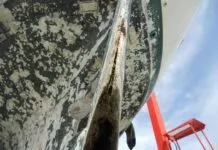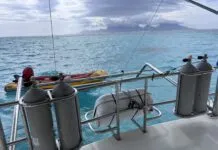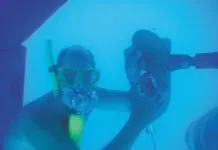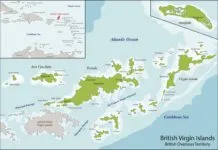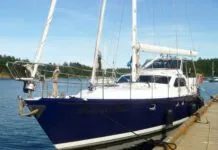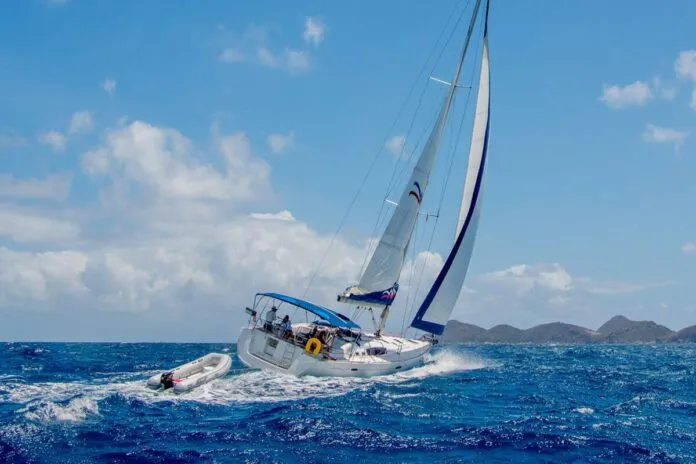
Assuming you’ve read my previous articles on this subject, you’ve now decided where you want to go and what type and size of boat to charter. The next step is to read and satisfy all the requirements provided in the charter company’s charter booking package, including sending the sailing resume, confirming charter and flight dates, digitally sending the deposit and signing the contract. You also need to let the charter company know your flight dates. Make sure to keep all email communications between you and the charter company in case you need to refer to them later on.
Prior to completing the aforementioned details, we also prepared and presented a tentative sail plan and budget to our friends who are coming with us and agreed on options and choices. For example, instead of filling in and sending a grocery list, we will go shopping ourselves. In this case, the grocery store is practically across the street from the charter base, BVI Yacht Charters, so it is convenient to do this task ourselves. You can see our sample budget here and download it as a template for your own planning.
MONOHULL OR CATAMARAN
Another important choice we had to agree on was the boat. Will it be a monohull or catamaran? Catamarans are more expensive, but offer much more room, privacy (as each couple would have their own hull) and comfort. On the other hand, a monohull can be sportier and would be heeling most of the time under sail. That’s why, if it’s just the two of us, we take a less expensive monohull. But if we’re two or more couples, the extra cost of a catamaran might be best. Remember, that the cost of the boat stays the same whether you are two, four, six etc. So, the cost per person can make a bigger boat more affordable than you think.
One of my best pieces of advice I can give you is whether you opt for a monohull or a catamaran, make sure each couple has their own head (bathroom)! Trust me, it can make a big difference in the overall enjoyment of the boat.
Here is an example of the cost difference for a comparable monohull and catamaran. Each couple would have their own room and dedicated head for both options. (These are 2025 season prices in USD for BVI Yacht Charters).
Jeanneau Sun Odyssey 410


Lagoon 38


LESSONS LEARNED
Between my wife and I, this will be our fifteenth bareboat charter in the Caribbean and our sixth in the BVIs. So, we pretty much know where to go and what to expect. We’ve also learned many valuable lessons on how to avoid potential issues onboard and always discussed these before hand with our friends.
- Do not bring too much clothing. By far, this is the most common first timer mistake. Most days will be spent in bathing suits, coverups, shorts, t-shirts and flip-flops. Most charter companies provide a suggested list of items to bring.
- If possible, travel with a carry-on sized luggage. Depending on the boat, space onboard is limited. So, avoid large luggage pieces. Besides, if you can fill a large luggage, you are bringing too much!
- Use charter company provided fins to save luggage space. Most charter companies offer masks, snorkels and fins at no charge. We travel with our own masks and snorkels, then use the provided fins.
- Dry bag. Bring a collapsable dry bag to go ashore in order to protect and carry anything you might need including dry towel, sunscreen, etc.
- Remember to fill and bring any prescriptions you might need.
- Initial groceries. Using the sail plan as a guide, estimate how many meals will be onboard. Ask if anyone has any food restrictions, then buy what you all agree to and split the bill. If someone wants something uniquely for themselves, they simply pay for it themselves. You can also prepare your order online before you go! Check out the Online Groceries in the BVI | RiteWay Food Markets website where you can browse all departments, including wine and spirits, and add to your cart what you need. Let them know your arrival date and your order will be ready for inspection and pick-up. Or have it delivered to your boat.

Fruit and veggies section at the local RiteWay grocery store, where you can order online, have it delivered onboard or go pick it up yourself. - Fruits and veggies. Fresh fruit and veggies will ripen quickly onboard, so choose wisely and prepare to eat these in the first few days. When possible, we select canned veggies. Remember also that fridge and cooler space is limited. Take a good look at the available space onboard before going to the store.
- Alcohol and spirits. Except for agreed upon beverages, like beer, wine, and rum, etc. where the cost is split evenly, everyone pays for anything else they want. In my case, for example, I am usually the only one that drinks Scotch. So, I pay for it myself.
- Buy many cases of water. For a party of four adults, for 10 days, four cases of 12 large (plastic) bottles should be good. The water onboard is to wash dishes, shower, heat up food that is inside sealed bags, etc. We never use onboard water for coffee, boiling pasta, to brush our teeth or drink.
- Common expenses. To avoid any issues once onboard, everyone contributes $100/per person into an envelope. This fund will be used to pay all common expenses, such as ice bags, food staples along the way, water top-ups, etc. If the fund runs low, everyone adds another $100. At the end of the trip, whatever is left, is split equally.
- Chart briefing. Make sure everyone is present, as you may elect to change some items on your sail plan based on new information.
- Boat inventory. The boat inventory and check out is not only to make sure everything listed is onboard and in good order but, more importantly, to make sure everyone knows where everything is. If a breakdown should happen, for example, you need to know where the tools and replacement parts are located like the first aid kit, VHF radio, EPIRB, flares, etc.
- Be flexible. Many things might come up that may hinder your plans. Rain, busy anchorages, etc. Be willing and ready to change your plans and roll with it. We’ve discovered may great spots because we had to make changes at the last minute.
BEFORE YOU GO

Underwater check. A note about the pre-departure check-out process. Out of an abundance of precaution, when signing off on the boat, I always write down that I will check below the waterline within 24 hours of leaving the base. Normally at the first anchorage, I will dive under the boat with my mask and camera to make sure there are no pre-existing damages to the hull, keel, rudder, prop and shaft, etc. If I spot anything, I take digital pictures which will be date and time coded. I will then alert the base that all is well or share my findings.
Besides making sure all is in good order, it is a good to know what the bottom and keel look like. The ability to visualize what is going on below the water line can be helpful, especially in an accidental grounding!
Boaty Ball is a site that allows you to pre-book a mooring ball at your intended anchorage for that night. Having the ability to prebook a mooring ball allows you and your crew to take your time and enjoy sailing and stops along the way instead of rushing to make sure you have a spot. As soon as you arrive on your charter boat, enter your boat details.
To book a mooring, simply open the site, zoom in close on the anchorage you want to go to and pick an available orange ball. That’s it! Your credit card will be charged (approx. $50 USD/per night). There are also blue, first come first serve mooring balls. If you don’t want or can’t book a ball and you’re lucky, you can grab one of those ($40/per night). It is recommended you book your mooring ball around 7 a.m. Note that you can only prebook a ball for the same day. You cannot prebook a day or more before.
If you do book a ball and find someone has already hooked up to it—by accident, perhaps—there is a very effective resolution process that BoatyBall has that will ensure a quick solution. Normally, a manager located in the bay itself will be called upon to get the squatter off your ball or will assign you another ball if the squatters are not onboard at that moment. However, they tell me this is a very rare occurrence.

Since BoatyBall does not have moorings available in all BVI anchorages, and some locations may be full, your anchoring skills will come in handy. Unless, of course, you can simply stick to anchorages that do offer mooring balls.
I hope you enjoyed this article and that it helps demystify bareboat chartering, and gives you the confidence to get this amazing bucket list item checked off. In our case, we’ve checked it off but somehow it keeps popping back up on our list!
SOME BAREBOAT CHARTER COMPANIES SERVICING THE BVIS
For more, search “Bareboat charter companies in the BVI” and do visit www.BVITOURISM.com
REFERENCES
The Cruising Guide to the Virgin Islands
The Guide to the Windward Islands
The Guide to the Leeward Islands









